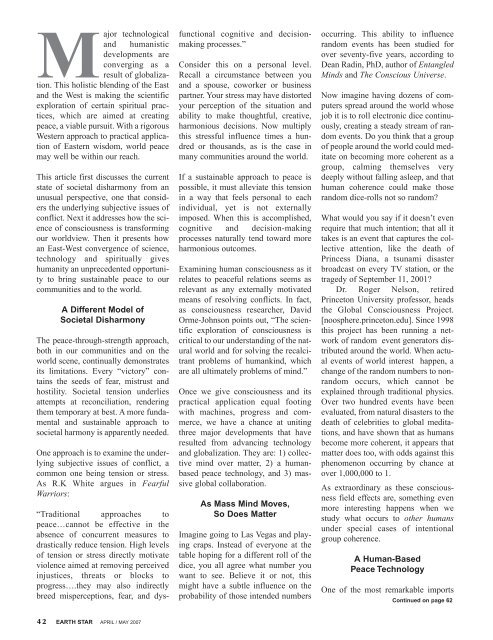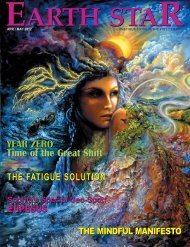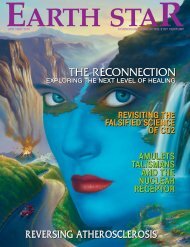You also want an ePaper? Increase the reach of your titles
YUMPU automatically turns print PDFs into web optimized ePapers that Google loves.
Major technologicaland humanisticdevelopments areconverging as aresult of globalization.This holistic blending of the Eastand the West is making the scientificexploration of certain spiritual practices,which are aimed at creatingpeace, a viable pursuit. With a rigorousWestern approach to practical applicationof Eastern wisdom, world peacemay well be within our reach.This article first discusses the currentstate of societal disharmony from anunusual perspective, one that considersthe underlying subjective issues ofconflict. Next it addresses how the scienceof consciousness is transformingour worldview. Then it presents howan East-West convergence of science,technology and spiritually giveshumanity an unprecedented opportunityto bring sustainable peace to ourcommunities and to the world.A Different Model ofSocietal DisharmonyThe peace-through-strength approach,both in our communities and on theworld scene, continually demonstratesits limitations. Every “victory” containsthe seeds of fear, mistrust andhostility. Societal tension underliesattempts at reconciliation, renderingthem temporary at best. A more fundamentaland sustainable approach tosocietal harmony is apparently needed.One approach is to examine the underlyingsubjective issues of conflict, acommon one being tension or stress.As R.K White argues in FearfulWarriors:“Traditional approaches topeace…cannot be effective in theabsence of concurrent measures todrastically reduce tension. High levelsof tension or stress directly motivateviolence aimed at removing perceivedinjustices, threats or blocks toprogress….they may also indirectlybreed misperceptions, fear, and dysfunctionalcognitive and decisionmakingprocesses.”Consider this on a personal level.Recall a circumstance between youand a spouse, coworker or businesspartner. Your stress may have distortedyour perception of the situation andability to make thoughtful, creative,harmonious decisions. Now multiplythis stressful influence times a hundredor thousands, as is the case inmany communities around the world.If a sustainable approach to peace ispossible, it must alleviate this tensionin a way that feels personal to eachindividual, yet is not externallyimposed. When this is accomplished,cognitive and decision-makingprocesses naturally tend toward moreharmonious outcomes.Examining human consciousness as itrelates to peaceful relations seems asrelevant as any externally motivatedmeans of resolving conflicts. In fact,as consciousness researcher, DavidOrme-Johnson points out, “The scientificexploration of consciousness iscritical to our understanding of the naturalworld and for solving the recalcitrantproblems of humankind, whichare all ultimately problems of mind.”Once we give consciousness and itspractical application equal footingwith machines, progress and commerce,we have a chance at unitingthree major developments that haveresulted from advancing technologyand globalization. They are: 1) collectivemind over matter, 2) a humanbasedpeace technology, and 3) massiveglobal collaboration.As Mass Mind Moves,So Does MatterImagine going to Las Vegas and playingcraps. Instead of everyone at thetable hoping for a different roll of thedice, you all agree what number youwant to see. Believe it or not, thismight have a subtle influence on theprobability of those intended numbersoccurring. This ability to influencerandom events has been studied forover seventy-five years, according toDean Radin, PhD, author of EntangledMinds and The Conscious Universe.Now imagine having dozens of computersspread around the world whosejob it is to roll electronic dice continuously,creating a steady stream of randomevents. Do you think that a groupof people around the world could meditateon becoming more coherent as agroup, calming themselves verydeeply without falling asleep, and thathuman coherence could make thoserandom dice-rolls not so random?What would you say if it doesn’t evenrequire that much intention; that all ittakes is an event that captures the collectiveattention, like the death ofPrincess Diana, a tsunami disasterbroadcast on every TV station, or thetragedy of September 11, 2001?Dr. Roger Nelson, retiredPrinceton University professor, headsthe Global Consciousness Project.[noosphere.princeton.edu]. Since 1998this project has been running a networkof random event generators distributedaround the world. When actualevents of world interest happen, achange of the random numbers to nonrandomoccurs, which cannot beexplained through traditional physics.Over two hundred events have beenevaluated, from natural disasters to thedeath of celebrities to global meditations,and have shown that as humansbecome more coherent, it appears thatmatter does too, with odds against thisphenomenon occurring by chance atover 1,000,000 to 1.As extraordinary as these consciousnessfield effects are, something evenmore interesting happens when westudy what occurs to other humansunder special cases of intentionalgroup coherence.A Human-BasedPeace TechnologyOne of the most remarkable importsContinued on page 6242 EARTH STAR APRIL / MAY 2007
















